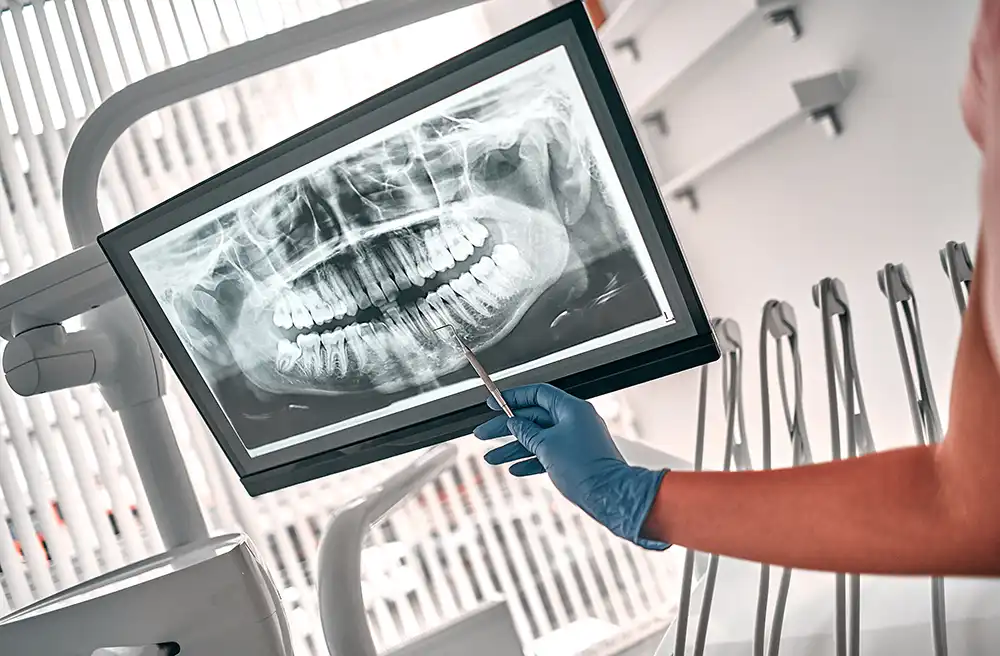We follow the guidelines from the ADA, and recommend routine, professional cleanings and exams for patients of all ages every 6 months, if not sooner for certain individuals. Our hygienists will remove bacteria, plaque, and calculus from tooth surfaces. These cleanings are essential to prevent and treat gum disease. The doctors will then provide a dental examination as part of routine preventative measure.
During your exam, your dentist will evaluate the hard and soft tissues of your head and neck. They will provide an oral cancer screening, evaluate your Temporomandibular joints (TMJs), review your xrays, and check for cavities or fractured teeth. Your dentist may also perform an examination of lymph nodes in your face and neck looking for any pain or abnormalities that could be indications of disease.
Xrays, or radiographs, are recommended regularly. The benefits of radiographs are very well-known in the dental and medical field. They allow us to see inside a tooth and beneath the gums, sometimes before problems are visible or painful to you. Radiographs are used to diagnose common problems, such as cavities, gum disease and some types of infections. Early detection is key for prevention. If anything is found, it is important to return for treatment as soon as possible and before it becomes painful or infected.
At Harmony Dental, we use patient-friendly digital radiography. Digital sensors are more responsive than film and less radiation is required to produce a digital image compared to film. The radiation dose from digital X-rays can be as little as 10 percent of what you would be exposed to with film-based radiography. A flight from Los Angeles to New York city provides 10 times more radiation than receiving a full set of dental radiographs. Even eating a banana is almost as much radiation as a single tooth radiograph.
Multiple different types of radiographs are used in the dental office. The type of radiograph your dental professional needs depends on the treatment being rendered.
- Panoramic Radiograph – This is a full view of bones in the face, teeth, and the adjacent structures like nerves and sinuses. These are taken by a machine that goes around your head. They are generally recommended as a part of initial treatment, for developing children, if any pathology is suspected, if orthodontic treatment is being pursued or oral surgery is necessary.
- Full Mouth Series (FMX) – An FMX is a combination of individual periapical radiographs which look at the base of the teeth in the bone. These, or a panoramic radiograph, are generally recommended as a regular part of treatment once every 5 years. This allows your dentist to evaluate the condition of each tooth and look for abnormalities such as infection.
- Periapicals – A single tooth periapical radiograph is an intraoral radiograph that looks at the base of the tooth in the bone. Often, these are taken if a tooth is painful, if a large cavity or fracture is noted, or to check for infection.
- Bite-Wings – These are generally recommended and taken as a regular part of treatment once each year. A bite wing radiograph is commonly obtained to diagnose decay (or cavities) between teeth, evaluate conditions of dental work, and occasionally to check the amount of tooth structure above the bone.
Common recommendations for a healthy smile:
- Brush your teeth at least twice daily for 2 minutes (morning and evening is recommended). Remember to brush your tongue! Sonicaire toothbrushes are available for purchase in our office.
- Floss between your teeth at least once daily to remove plaque and food particles. Mouthwash can also help to kill bacteria and restore fresh breath.
- Eat a balanced diet full of fruits and vegetables.
- Avoid high frequency of sugary and acidic foods. It is a good idea to rinse or brush afterwards.
- Take preventive measures, like routine cleanings and checkups and possible sealants.
Learn about proper brushing as well as the difference between a Sonicare and a manual toothbrush.
View Other Services

